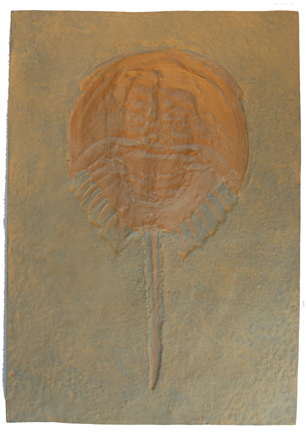 |
 |
 |
 |
 |
Produced
by the Population Genetics and Evolution class, Furman University |
||||
 |
 |
 |
 |
 |
Produced
by the Population Genetics and Evolution class, Furman University |
||||
 |
The
Silurian: Xiphosurans |
 |
||
| Xiphosurans
are an ancient order of marine chelicerates, distantly related to other
chilicerates like scorpions, spiders, and extinct eurypterids. They evolved
in the Siluran, with the oldest known fossils dating to around 435 mya
(Anderson 2008). There is one extant lineage today, represented by three
genera and five species of 'horseshoe crab' (Kazlev 2002). Three major
parts make up the exoskeleton of these organisms, which has barely changed
in 250 million years (Kazlev 2002). These parts include the prosoma, which
is the large, distinctive cephalothorax, the opisthosoma, and the telson
(the long tail-spine; Kazlev 2002). The anterior portion of the prosoma
is called the carapace, which anchors the eyes beside the midline. This
is used as a “digging tool,” which allowed them to dig pits
for eggs, protection, and sources of food (Anderson 2008). The opisthosoma’s
main function is to protect the 5 pairs of gills, which possess flaps
that allow it to propel itself via strenuous flapping (Kazlev 2002; Anderson
2008). They also possess other appendages including six pairs of legs;
however, they do not have antennae (Kazlev 2002). Modern horshoe crabs
can be up to 60 cm, but the earliest species were far smaller, often only
a few centimeters in length (Wikipedia 2010). Page by Matt Medlin |
 |
| Xiphosura fossil, Mesolimulus. Picture From: Prehistoric Planet Store. | |
| Anderson LI. 2008. Fossil and Living Horseshoe Crabs. Accessed Feb. 2010. Wikipedia. 2010. Xiphosura. Accessed Feb. 2010. Kazlev, A. 2002. Xiphosura. www.palaeos.com. Accessed Feb. 2010. |